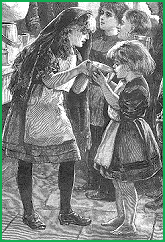In 1834,
just 3 years before Victoria became Queen, an Act
of Parliament was
passed called the Poor Law Amendment Act.
As a result of this many workhouses were built to accommodate poor people.
They were intended to be so harsh and hostile that only the truly
destitute would seek refuge
in them.
 It
was hoped that the workhouses would solve the problem of poverty as many
rich people believed people were poor because they were lazy. They called
them the "undeserving poor".
It
was hoped that the workhouses would solve the problem of poverty as many
rich people believed people were poor because they were lazy. They called
them the "undeserving poor".
Many families, and the old and sick were so poor they were classed as paupers. Pauperism was a term used to describe people who had no means to support themselves. Poverty was not caused by laziness as wealthier people thought but by unemployment, population increase and high food prices.
Act of Parliament
- the written law of a country.
Destitute
- a state of extreme poverty.
Pauper
- a very poor person.
Decade
- ten years.
Orphan
- a child without parents.
